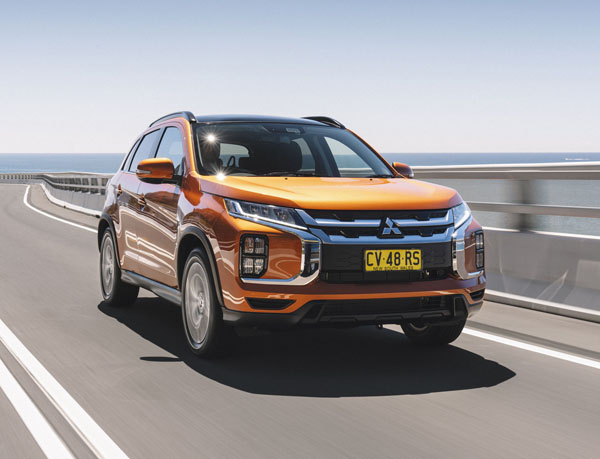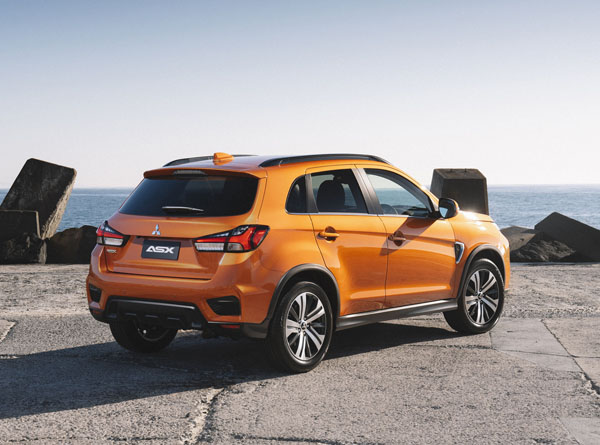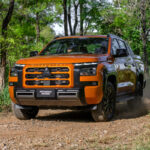 Mitsubishi has made significant revisions to its ASX small SUV. It’s been on sale here since 2010 and frequently outsells all others in its class due to keen pricing. These latest revisions have resulted in minor price increases but it still offers excellent value for money.
Mitsubishi has made significant revisions to its ASX small SUV. It’s been on sale here since 2010 and frequently outsells all others in its class due to keen pricing. These latest revisions have resulted in minor price increases but it still offers excellent value for money.
The most significant changes are a 2.4-litre engine that joins the existing 2.0-litre unit. It is fitted to the top of the line Exceed and the sporty GSR
The revised Mitsubishi ASX ES, LS and Exceed are available now, but the MR and GSR won’t be reach us Downunder till a date yet to be announced in December.
STYLING
Restyle of Mitsubishi’s big selling ASX give it a new look that’s significantly different to its predecessors. In fact you wouldn’t have to see new vs old side-by-side models to pick which is which.
Naturally the revised ASX features the successful “Mitsubishi Dynamic Shield” front end. A new design side garnish works nicely with the profile and there are mild changes at the rear.
ASX’s front lights certainly standout in their shape and complexity – we counted no fewer than 14 of them! Try for yourself if you don’t believe us. Black and chrome finishes have been added to the new-shape front bumper and grille. The semi-sporty GSR has a rear spoiler.
INTERIOR
Inside are black cloth headlining, microsuede and leather-look seats with red stitching. The ASX Exceed, the subject of our road test, has leather seats. See the Infotainment section of this review for details on its improvements.
INFOTAINMENT
An eight-inch display screen replaces the previous seven-inch unit. Infotainment includes Apple CarPlay and Android Auto and DAB radio.
The ASX Exceed also gains a Rockford Premium Audio system and TomTom navigation.
ENGINES / TRANSMISSIONS
The ASX Exceed and the new GSR model have a 2.4-litre engine with power of 123kW and torque at 222Nm. The other models retain the existing 2.0-litre powerplant (110kW/197Nm). The turbo-diesel engine was never popular in the ASX and was discontinued in 2017.
Transmissions are six-speed manual, six-speed automatics on diesels and CVT auto on petrols.
All-wheel drive and two-wheel drive (the fronts) are offered.
SAFETY
Active Stability Control is now standard across the Mitsubishi ASX range.
Electrochromatic rear view mirror and Forward Collision Mitigation, previously part of the ASX with ADAS package, are now also standard in all variants. The FCM detects obstructions ahead and issues a visual and audible alert when there is a danger of a collision, automatically applying the brakes to either avoid a collision or reduce the impact.
Mitsubishi ASX ES can ordered with the ADAS package for $2500 extra, with additional features, including lane departure warning, automatic low/high beam, reverse sensors, blind spot warning, lane change assist and rear cross traffic alert
An Emergency Stop Signal System automatically flashes the hazard lights to warn the driver behind when hard braking is detected at speeds above 55km/h.
DRIVING
The new Mitsubishi 2.4-litre engine has plenty of grunt and will even give a short period of torque steer if you give it a bootfull off the line. It’s nicely response, which makes a pleasant change from the small displacement turbo-petrol engines that are becoming increasingly common.
We didn’t get to sample the existing 2.0-litre engine during our initial drive program on the ASX’s media launch out of Byron Bay. We may be able to get one later, but suspect that Mitsubishi Australia will only put the new engine on the press fleet. Stay in touch.
Mitsubishi’s suspension guys and gals have done an excellent job of updating the ASX. Despite being nine years old it feels as though it only has two or three years under its wheels.
Steering has a nice feel and generally passes its messages to the driver in a satisfying manner. It’s no sports sedan (but see the previous comments on the big engine). Cornering is simple and the ASX generally follows the chosen line without you having to correct it midway through.
Road noise is generally well damped, but some stretches of Australia’s notorious coarse-chip surfaces set up a huge racket in the cabin. Enough to make you need to turn up the sound system.
The seats are comfortable and the back seats can take four in comfort, five at a squeeze. There’s enough legroom in the rear, though there times when the driver may have to move up to make some behind them to relax.
Mitsubishi ASX is not really an SUV and only has 2WD (the front wheels) but is hardly alone in this.
SUMMING UP
Mitsubishi has done an excellent job of keeping its ageing ASX pretty well up to date. As before, it’s extremely well priced and it’s likely to stay at, or very close to sales leadership in its class.
Mitsubishi Australia tells us an all-new model ASX is in the design stages, but won’t reveal when it’s due to be launched – or whether it will continue to be named ASX. We will provide further information as we receive. May we speculate that it’s at least 18 months away?
AT A GLANCE
MODEL RANGE
ES 2.0-litre: $24,990 (manual), $26,740 (CVT)
MR 2.0-litre: $28,240 (CVT)
LS 2.0-litre: $30,240 (CVT)
GSR 2.4-litre: $32,240 (CVT)
Exceed 2.4-litre: $35,740 (CVT)
Note: These prices do not include government or dealer delivery charges. Contact your local Mitsubishi dealer for drive-away prices.
SPECIFICATIONS (Mitsubishi ASX 2.4-litre petrol five-door wagon)
ENGINE:
Capacity: 2.360 litres
Configuration: Four cylinders in line
Maximum Power: 123 kW @ 6000 rpm
Maximum Torque: 222 Nm @ 4100 rpm
Fuel Type: Standard unleaded
Combined Fuel Cycle (ADR 81/02): 7.9 L/100km
CO2 Emissions: 186 g/km
DRIVELINE: Continuously variable transmission
DIMENSIONS, WEIGHT AND CAPACITIES:
Length: 4365 mm
Wheelbase: 2670 mm
Width: 1810 mm
Height: 1640 mm
Turning Circle: 10.6 metres
Kerb Mass: 1390 kg
Fuel Tank Capacity: 63 litres
BRAKES:
Front: Ventilated disc
Rear: Solid disc
STANDARD WARRANTY:
Five years / 100,000 kilometres













